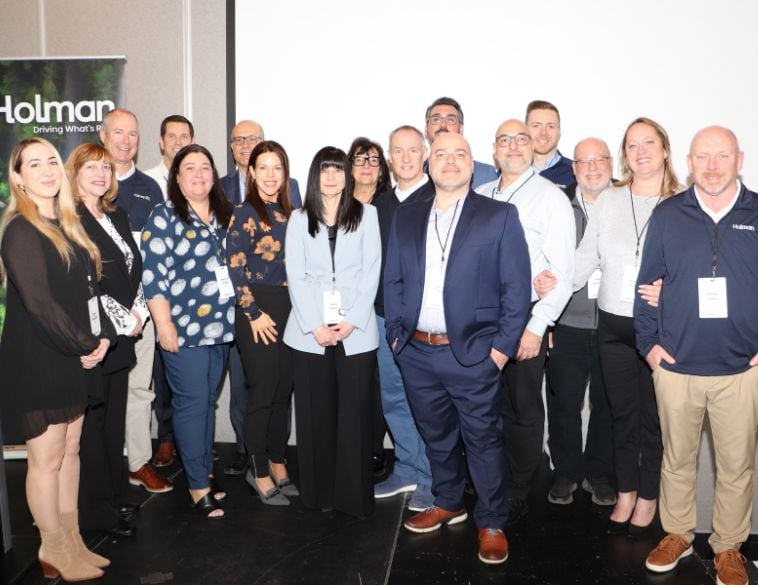Holman’s Montreal Customer Forum took place in Laval on April 11, bringing together speakers, fleet managers, suppliers and automaker representatives.
As Michelle Haddow, Regional Sales Manager for Holman, pointed out at the outset, the company, which is celebrating its 100th anniversary this year, is a world leader in fleet management. Holman provides fleet managers with the digital tools they need to optimize the management of their vehicle fleets.
She also pointed out, before turning the floor over to the speakers, that Holman presents these forums across Canada.
The first speaker, Romy Bria, Vice-President, Customer Relations at Holman, presented an analysis of the market and fleet performance. He used a sales services business model to illustrate his points.
“We’ve seen the evolution of fleets over the years. Whether it’s connectivity or the arrival of electric vehicles, the field has become more complex over the past five years,” he said.
Measuring fleet success
This specialist spoke of ways to measure the success of today’s fleets, particularly in terms of total cost of ownership (TCO). He explained the value of benchmarking against other fleets, but also of measuring internally the different sectors of activity, the performance of its vehicles or drivers.
Bria also addressed the issue of rising vehicle maintenance and acquisition costs. Returning to his example of a fleet dedicated to sales services, he points out that 89% of it is made up of SUVs. The price of parts for their maintenance has risen by an average of 10-20% since 2020. The cost of acquiring new vehicles has risen by 15% to 20% over the same period, as have monthly payments, which have jumped by 39%. The only good news is that fuel prices have fallen by 27% since June 2022.
The Black Book retention index has risen by 39% since 2019, which means high resale vehicle values, a phenomenon that will fade as new car availability increases.
Talking about the replacement threshold, he mentioned the importance for companies to establish a strategy ensuring constant turnover. Establishing the cost of maintenance per kilometer is a good indicator. “Be forward-thinking, because vehicles need to be available at the right time.”
According to the strategy, we could be talking here about replacing a third of the vehicles in the fleet annually. However, he understands that certain factors can play into this strategy, such as the desire to reduce fleet volume or delayed deliveries.
Telematics and maintenance
Eric Attias, Vice-President of Sales for Canada at Holman, followed by talking about the importance of making fleet decisions based on numbers. In this respect, telematics is an essential tool. He also talked about optimal fleet performance, replacement programs, the importance of preventive maintenance, and the importance of planning for the electrical transition.
“The sector is affected by inflation, and we expect maintenance costs to rise by 7.5% in 2024. Add to this the labor shortage and the increase in the average age of vehicles since the pandemic. Fortunately, replacement parts are more readily available. Follow the preventive maintenance program and check major repairs. We want to avoid unplanned downtime.
Like his colleague, he stresses the importance of setting targets and budgets over long periods. “With the right data in hand, we can be flexible with suppliers and vary models, eliminate extra vehicles or even revisit the notion of a single driver on the same vehicle to make the fleet more efficient,” Attias explains.
The objective of having an optimally sized fleet relies on the analysis of data that will indicate actual vehicle use. He also points out the need to be flexible, allowing forecasts to be changed along the way in the light of real needs.
The impact of eliminating subsidies
Attias concluded his presentation by detailing the Quebec government’s decision to reduce and then abolish rebates for the acquisition of electric and hybrid vehicles under the Roulez vert program. “The industry was expecting this, but not so quickly. We’ll have to see what impact this abolition will have on EV sales, and also what the federal government’s decision will be on this subject in its next budget. What is certain is that there is still no parity between the cost of acquiring a gasoline-powered vehicle and its electric equivalent.”
The third speaker, Mike Stallone, Holman’s Vice-President of Applications Development, provided an update on his company’s work in developing technological tools to enhance customer performance.
“Our goal is to facilitate interactions, reduce irritants, improve visibility and enhance the experience for our customers. We want them to find the information they need more easily.”
An evolving platform
Several new features are under development to enhance the performance of the platform and dashboards displaying key performance indicators (KPIs). More specific applications, such as the one for drivers, will also be enhanced. For example, drivers will be able to view the location of North America’s 60,000 electric charging stations directly on their cell phone. It will also be possible to access a statement of charging station consumption at home for reimbursement to the worker.
On the same planet
Two-time Olympic champion and investment advisor Alexandre Bilodeau was the seminar’s special guest. He spoke about the mental strength required for success. “People think we athletes live on another planet,” he said. But there are parallels in our lives. Hard work and determination are common values.”
He explained that even to perform in an individual sport success relies on teamwork. “Like an entrepreneur, success is knowing how to surround yourself with the right people. We give ourselves goals to reach, and then we have to work on having the tools to achieve them. And these objectives must evolve, as must the situation. Take the time to step back and learn from your mistakes, as I did in my sporting career. You mustn’t promise the result, but commit to being ready and that you’ll have the people around you to succeed.”
This testimonial brought the meeting to a pleasant close.



